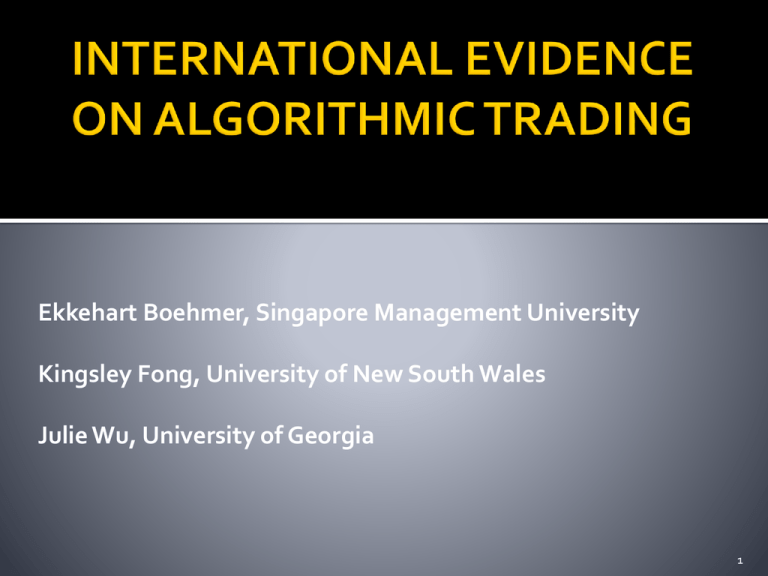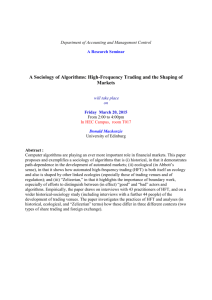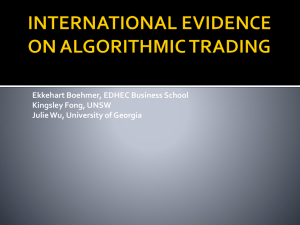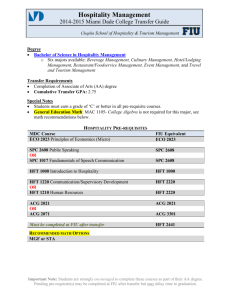Ekkehart Boehmer, Singapore Management University Julie Wu, University of Georgia
advertisement

Ekkehart Boehmer, Singapore Management University Kingsley Fong, University of New South Wales Julie Wu, University of Georgia 1 High frequency trading (HFT): activity of algorithms that submit and cancel orders, reacting within milliseconds to market updates . HFT is for real – between 60% and 80% of trading volume. HFT strategies are not transparent 2 Regulators and academics are interested in the consequences of HFT for • • • market quality welfare (of traders, society, …) systemic risk Our study focuses on market quality. 3 Depends on strategies Passive market making should improve liquidity Stat arb should improve efficiency Structural and directional strategies could be wealth transfers Algorithmic trading (AT) is a precondition for all HFT strategies. Since actual strategies are not known to researchers, most research studies the AGGREGATE EFFECT of AT/HFT. 4 Data used Transactions data where AT/HFT is inferred indirectly from the rate of electronic message traffic ▪ cost and speed consideration - > electronic orders ▪ commonly used as a proxy by consultants, exchanges and other market venues Transactions data with trader category information that have a set of transactions attributed to AT/HFT Transactions data with trader account information 5 Hendershott, Jones, and Menkveld (JF2011): electronic message counts from NYSE’s System Order Data (SOD) database as a proxy for AT concentrate on 2003 NYSE autoquote event algo trading improves spreads and price discovery, reduces information asymmetry Hasbrouck and Saar (JFM 2013): similar findings with HFT inferred from ITCH millisecond episodes. Eggington at al. (WP2014): liquidity worsens on extremely high-volume days 6 Brogaard (and his coauthors), in several recent papers, uses a 2008-2009 random sample of 120 Nasdaq stocks with 26 HFT firms HFT activity is associated with better liquidity, mixed effect on volatility, better price discovery Potential selection issue with exchange-selected HFT firms ▪ nature of order flow, fraction of order flow, no large proprietary trading desks 7 Kirilenko, Kyle, Samadi, and Tuzun (WP 2014) see individual strategies in S&P500 E-minis find that HFT may have worsened (but did not cause) the Flash Crash on May 6, 2010. Baron, Brogaard, and Kirilenko (WP 2014) find large returns in E-minis for top performing HFT firms. 8 Broaden the scope of evidence on AT/HFT to an international sample over a long period and assess effects on liquidity price efficiency volatility Examine differences in the cross section of firms Size, price level Study AT/HFT liquidity provision in different market conditions 9 10 • Intraday quote and trade data from Thomson-Reuters Tick History (TRTH) and Trades andQuotes (TAQ) 42 stock exchanges, 37 countries, 2001-2011 on average about 21,552 common stocks per year Daily data on returns, volume, price from Datastream and Center for Research in Security Prices (CRSP) Buy-side transaction costs data from the Ancerno database Information about trading protocols from Reuter’s Speedguide, Exchange Handbook, World Federation of Exchanges 11 12 AT = - trading volume / # messages volume per message times (-1), (US$100) ▪ follows Hendershott, Jones, and Menkveld (JF 2011) ▪ normalize raw message traffic with trading volume ▪ messages include trades and quote updates ▪ for the US, TAQ and System Order Data (SOD) based measures are highly correlated 13 Spreads RQS=(Ask-Bid)/M, RES=2*|P-M|/M ▪ P is transaction price, M is bid-ask midpoint Amihud = |daily return|/dollar volume Short = Dk * ( XP – RP ) / RP ▪ execution shortfall : Ancerno actual (buy side) institutional price impacts. ▪ XP is the volume weighted average price across component trades of a daily order ; RP is the reference price, defined as the opening price on the day of the order; D is buy(sell) indicator 14 |ARn| for various time intervals for each stock, compute mid-quote returns for various intervals then compute autocorrelation of returns ignore overnight returns ▪ no bid-ask bounce in this measure The more efficient the stock price (the closer it is to a random walk), the smaller is |ARn| 15 Use several standard volatility measures |Ret|, Ret^2 for stock raw daily return |MktadjRet|, MktadjRet^2, for market-adjusted daily return Log (Ret10_Var), Log (Ret30_Var) ▪ Intraday return variances computed from 10-min and 30-min mid-quote returns daily relative price range = (High-Low)/Close 16 17 Have three-dimensional unbalanced panel 42 markets, about 2770 days, about 550 stocks per market Main method: estimate firm and day fixed effects panel regression for each market, then aggregate across markets All variables are winsorized (99.5% and 0.5%) and standardized daily within a market so coefficients are comparable across markets 18 Regress market quality measures on AT proxy and controls All regressions control for volume, volatility, inverse price, firm size ▪ volatility regressions exclude volatility control and add controls for RES and |AR| Inference is based on means across markets (42 coefficients, use cross-sectional t-test for inference) 19 20 RQS Mean coef. on AT -0.0093 t-stat -6.69 % positive** 2% RES Amihud -0.0097 -3.52 26% -0.0110 -6.81 5% More AT activity is associated with higher liquidity (i.e. lower spreads and smaller price impact). 21 How does the relation between AT and liquidity differ for stocks with different characteristics? Sort within each market according to firm characteristic (e.g. SIZE) Create dummies for Small and Large tercile Include interactions with AT in regression models 22 Solid colors indicate significance at the 5% level More AT is associated with better liquidity in medium and large stocks 23 Mean coef. on AT t-stat % positive** |AR10| |AR30| -0.0126 -7.23 7% -0.0042 -4.01 14% More AT activity is associated with better informational efficiency. 24 More AT is associated with consistently better price efficiency in large stocks. 25 |ret| Ret^2 Mean coef. of AT 0.027 0.0182 t-stat 7.65 6.67 %positive** 81% 81% Ln(Ret10_ Ln(Ret30_ PriceRange Var) Var) 0.0401 0.0216 0.0295 8.52 4.25 5.17 83% 71% 79% • More AT activity is associated with higher volatility. • control for efficiency and liquidity. 26 The positive ATvolatility relation decreases with firm size. 27 A two-step procedure 1. estimate a cross-sectional regression within each market each day, using liquidity, efficiency, and volatility as dependent variables, and record the AT coefficients. 2. compute Spearman rank correlations between AT coef on liquidity and AT coef on volatility. The correlations are positive (0.02 - 0.14). On an average day, when AT is associated with higher volatility, AT also is associated with wider spreads. 28 Probably not. Controlling for the efficiency of prices in regressions produces the same result. This implies that higher volatility cannot easily be attributed to greater price efficiency accompanied with higher AT. 29 Identify days when market making is difficult MMs dislike one-sided order flow that moves price. E.g., consider sell imbalance: price moves down, MM is long, faces inventory losses Tend to cut back on liquidity provision on such one-sided trading days Tend to cut back more when imbalance continues through the next day 30 Select all days when the daily return has the same sign as the previous day’s return Set HARD dummy to one on these days if the 2-day cumulative return exceeds the 20-day historical mean by at least one standard deviation Then interact with AT as before 31 More AT is still associated with higher liquidity, but this is significantly less than on regular days Greater information content of trades (RPI) Smaller reward for providing liquidity (RRS) More AT, higher volatility and efficiency If AT use MM strategies on average, they tend to resort to other strategies when market making is unusually difficult. 32 The importance of traditional vs. HFT market making should increase with AT. Compare low-AT tercile (“traditional MM”) with high-AT tercile (“new MMs”) by estimating the HARD interactions separately 33 AT benefits are concentrated in traditional MM stocks, especially on HARD days. Negative AT association (higher volatility, no liquidity improvement) are concentrated in new-MM stocks where traditional MMs are less important. Not clear that HFT MM are substitutes for traditional MMs, consistent with Anand and Venkataraman (2012). 34 Use co-location within each market as an instrument for AT Estimate IV regression at the market level 1. compute value-weighted daily averages for each market 2. estimate first stage regressions of AT on colocation dummy variable with market and day fixed effects 3. estimate second-stage IV model using predicted values from 2 35 Dependent variable RQS RES Amihud Shortfall AT coefficient -0.023 -0.045 -0.003 -0.024 t -4.06 -7.12 -0.32 -1.95 |AR10| -0.041 -4.00 PriceRange ln(Ret10_Var) |Ret| 0.060 0.076 0.066 9.99 15.62 9.16 Results are largely unchanged with IV. 36 Results maintain if we control for news announcements exclude financial crisis period use Fama-McBeth regression for weekly or monthly aggregation periods run time-series regression at firm level first, then aggregate across firms 37 Algo trading improves liquidity and informational efficiency increases volatility, even when controlling for efficiency and liquidity But Little liquidity effect in the smallest third of firms in each market AT increases volatility the most for small firms that are small. On days when market making is more difficult, AT provides less liquidity, increases information content of trades, and increases volatility more. 38 Volatility increases with more AT – what exactly are the implications? In assessing the current market structure, market observers should take into account that the effects of AT are not uniform across markets, across stocks, and over time. 39 40





